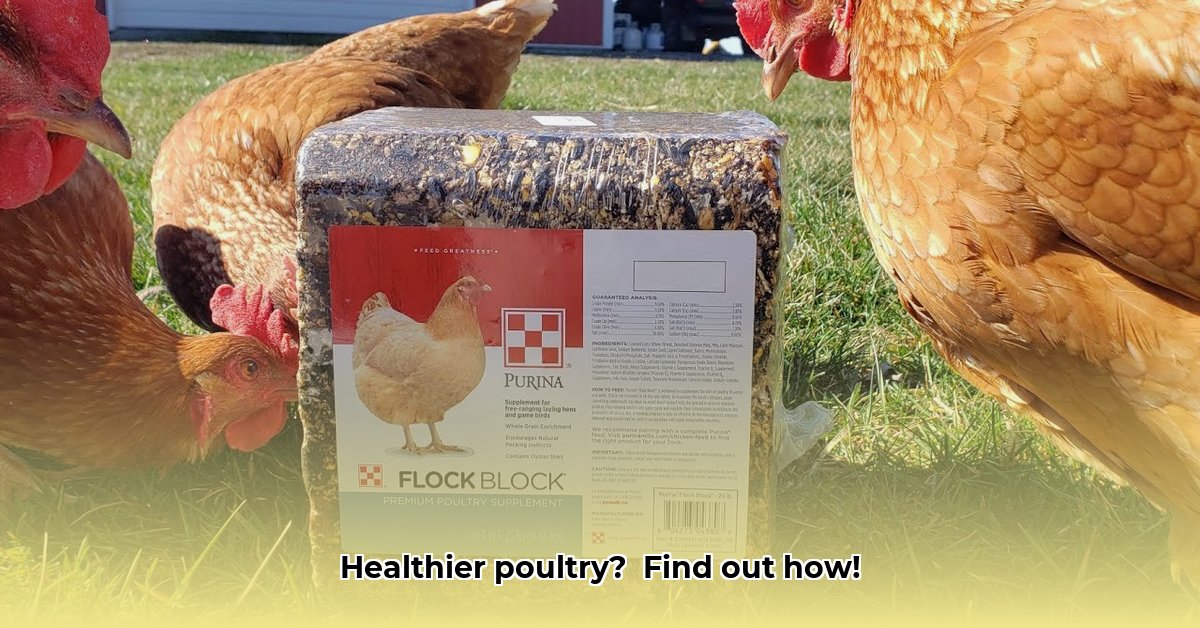
What's the Buzz About Purina Flock Blocks?
Happy, healthy chickens lay the best eggs. Finding the right feed is crucial, and Purina Flock Blocks are a popular choice among backyard poultry keepers and small-scale farmers alike. But are these blocks truly beneficial, or is the hype overblown? This article delves into the world of Purina Flock Blocks, exploring their benefits, limitations, and the practical considerations for incorporating them into your flock's diet. We'll examine the evidence, address some unsubstantiated claims, and equip you with the knowledge to make informed decisions for your chickens' well-being. For more on chicken keeping, check out these chicken coop plans.
Understanding Purina Flock Blocks: More Than Just a Treat
Purina Flock Blocks aren't a complete chicken feed; they're a supplemental feed designed to provide additional nutrition and enrichment. Think of them as a nutritious, palatable treat that encourages natural pecking behavior. The blocks typically contain a mix of whole grains, oyster shell (a crucial source of calcium for strong eggshells), and grit (to improve digestion). This blend aims to provide supplemental vitamins and minerals while also offering an engaging activity for your hens.
Benefits and Claims: Separating Fact From Fiction
Purina promotes Flock Blocks as improving eggshell quality and reducing boredom-related behaviors like feather pecking. While the provision of grit and the textural nature of the block undoubtedly contribute to digestive health and encourage natural pecking, substantial independent research verifying these broader claims remains limited. Further research is needed to fully establish the impact of Flock Blocks on overall hen health and egg production across various breeds and environments. "Research-proven" claims should be viewed with a healthy dose of skepticism until comprehensive study results are publicly available.
Practical Applications: A Step-by-Step Guide
Successfully integrating Flock Blocks into your flock’s routine requires careful management:
Gradual Introduction: Introduce Flock Blocks gradually over several days to allow your chickens to adapt to the new feed. Sudden changes can disrupt their digestive systems and eating habits.
Strategic Placement: Place the block in an accessible location, away from regular feed and water sources to prevent contamination.
Monitor Consumption: Regularly observe your flock's consumption of the blocks. If intake is low, consider adjusting placement or offering the blocks at different times of day.
Regular Observation: Monitor your chickens' behavior, egg production, and egg shell quality. Any changes may indicate a need to adjust the amount or frequency of Flock Block supplementation. Sudden changes warrant a consultation with an avian veterinarian.
Tailored Approach: Different breeds and ages may have varying nutritional needs. Remember that Flock Blocks are a supplement; a balanced diet with commercial layer feed remains critical.
Limitations and Considerations: The Missing Pieces
Despite their potential benefits, Flock Blocks come with caveats. A significant drawback is the lack of detailed nutritional information readily available to consumers. This lack of transparency makes it difficult to accurately assess the nutritional contribution of the block and to fine-tune supplementation strategies. Moreover, the efficacy of Flock Blocks across different chicken breeds and in various environmental conditions needs further investigation.
Risk Assessment: Potential Challenges and Mitigation Strategies
While generally considered safe, several potential risks warrant careful consideration:
| Risk Factor | Likelihood | Impact | Mitigation Strategy |
|---|---|---|---|
| Ingredient Supply Issues | Moderate | Moderate | Source from reputable suppliers; explore alternative sources. |
| Over-Reliance & Nutritional Imbalance | High | High | Supplement, don't replace, balanced layer feed; monitor consumption closely. |
| Misleading Marketing Claims | Low | Moderate | Cross-reference information with independent research and expert advice. |
| Environmental Impact (Packaging Waste) | Low | Low | Opt for sustainably packaged products; recycle or compost responsibly. |
Conclusion: Responsible Poultry Keeping Requires Informed Choices
Purina Flock Blocks can be a valuable supplemental feed, providing enrichment and additional nutrients. However, their effective use requires careful management, awareness of their limitations, and a commitment to responsible poultry farming practices. A balanced nutritional approach, regular observation of your chickens, and a push for greater transparency from manufacturers regarding product composition and efficacy remain crucial. Remember that a well-rounded diet and a stimulating environment are key elements of happy and productive hens.